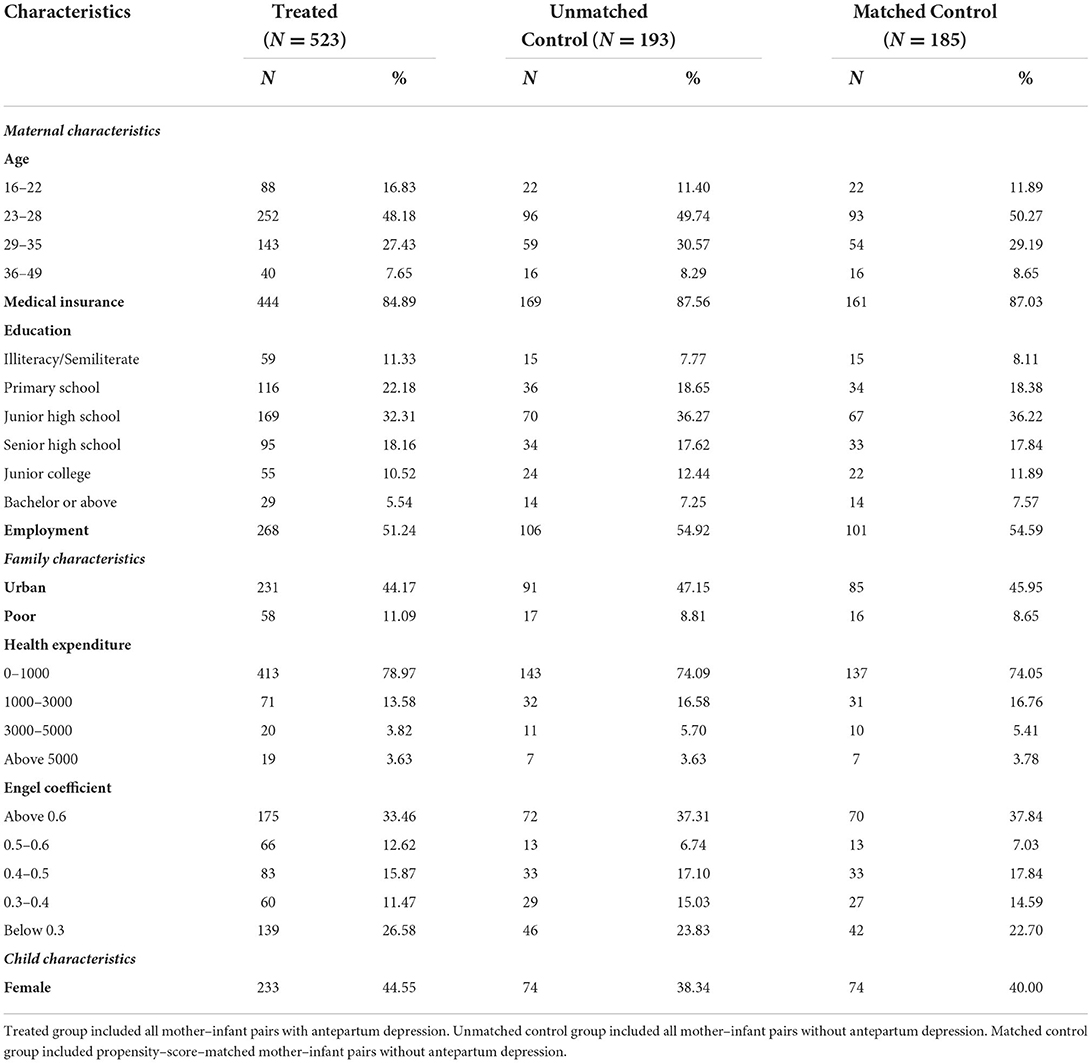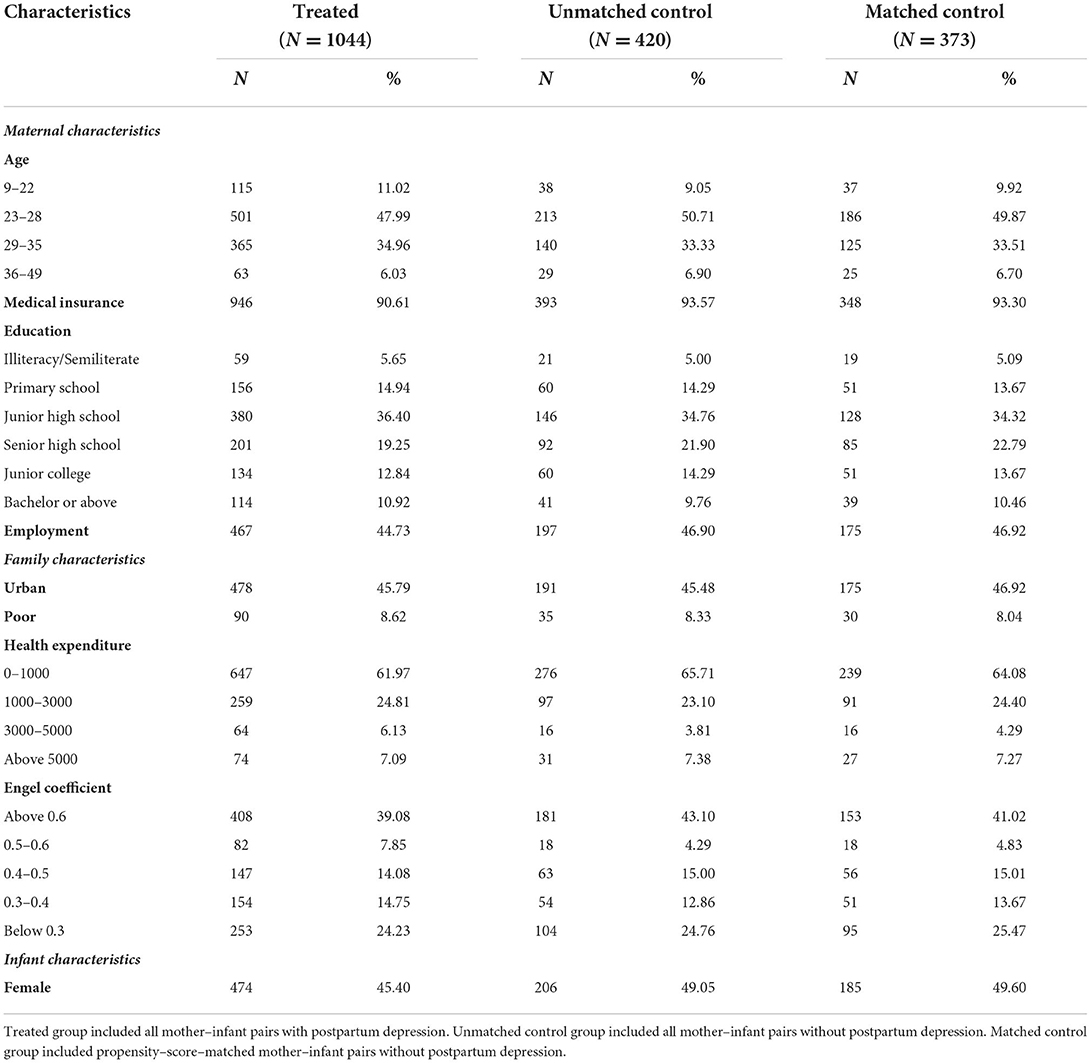- 1School of Public Policy and Administration, Xi'an Jiaotong University, Xi'an, China
- 2Vanke School of Public Health, Tsinghua University, Beijing, China
- 3School of Public Health and Emergency Management, Southern University of Science and Technology, Shenzhen, China
Background and aims: Maternal depression before and after delivery has dramatically increased in China. Therefore, this study aimed to examine the association between antepartum and postpartum depression and neonatal outcomes.
Design: A population-based retrospective cohort study.
Setting: China.
Participants: Data were obtained from China Family Panel Studies (CFPS). Different mother-child/infant samples were included in this study. Mother in CFPS2012 and CFPS2016 were linked with 1–2-year-old children in CFPS2014 and CFPS2018, respectively. Besides, and mothers in CFPS2012, CFPS2016, and CFPS2018 were linked with 0–1-year-old infants in CFPS2012, CFPS2016, and CFPS2018, respectively.
Methods: Maternal depression was measured using the Center for Epidemiologic Studies Depression Scale. The neonatal outcomes included duration of gestational days, preterm birth, birth weight, birth weight z-score, weight, weight z-score, illness in the past month, and hospitalization in the past year. Propensity score matching was used to balance maternal, family, and infant/child characteristics between the maternal depression and non-maternal depression groups.
Results: Multivariable regression analysis of matched samples estimated that antepartum depression was associated with a shorter duration of gestation by 3.99 days (95% confidence interval [CI] = −7.21, −0.78). The association between antepartum depression and preterm birth, birth weight and birth weight z-score were not statistically significant. Postpartum depression was associated with more episodes of illness in the last month by 0.23 times (95% CI = 0.11, 0.36) and a higher odd of hospitalization in the previous year (OR = 1.59, 95% CI = 1.15, 2.20). The association between postpartum depression and weight or the weight z-score was not significant.
Conclusion: Maternal depression appears to be associated with worse neonatal outcomes.
Introduction
The quality of the newborn population is an important indicator of a country's social economy and level of medical service. Improving the quality of the newborn population is of great significance for individuals, families, and society (1). Birth quality refers to the quality of the babies before and after they are born. Negative outcomes mainly include sub-healthy births, such as preterm birth, asphyxia, overdue delivery, and low birth weight, which often result in the death of babies or serious diseases and long-term disabilities in children. These factors closely correlate with newborn survival and lifelong health and may bring heavy medical burden to families and society (2, 3). Globally, the preterm birth rate in 2014 was 10.6%, equating to an estimated 14.84 million live preterm births in 2014 (4). The preterm birth rate has increased over the past two decades in almost every country where data are available; 1.1 million babies die from prematurity, and many survivors are disabled or illness like asthma every year (5, 6). Meanwhile, 20.5 million neonates were born with a low birth weight in 2015, and the survivors have a higher risk of stunting, lower intelligence quotient, andd cardiovascular disease later in life than their counterparts (3).
Recently, the proportion of newborns born with sub-health problems in China has increased alarmingly from 25% in 1980 to 65% in 2009. The average number of newborns born with sub-health in China is approximately 1 million every year, which is the main cause of death or disability in newborns in China (7). Monitoring of the quality of the birth population in China started late with small coverage, and the work is also focused on birth defects; thus, few data about sub-healthy births can be collected (2). If the quality of the birth population cannot be fundamentally improved, the number of defective and sub-healthy children will continue to accumulate, and the negative impact will continue to spread among the population, becoming an obstacle to the sustainable development of China in this new situation.
Maternal depression could be considered a potential factor for sub-healthy births. The symptoms of depressed pregnant women are not significantly different from other depressed patients, who may experience loss of appetite, difficulty sleeping, lack of energy, weight loss, and other symptoms (8–10). Moreover, they may smoke and drink more frequently but rarely in China because Chinese culture believes that drug abuse, smoking, and drinking can cause great harm to vulnerable fetuses (11). Chinese scholars surveyed 1,899 pregnant women in 2015 and found that the overall prevalence of prenatal depression was 33.6% (12). Fearful of the effects of antidepressants on their children, women are also less likely to seek medical help or follow medical advice; consequently, they become preoccupied with depressive thoughts, doubt their ability to be a parent, and, more seriously, may self-harm or even commit suicide (8–11). Some studies have demonstrated that depressed pregnant women may have a shorter birth duration (13), a greater risk of preterm birth, delayed fetal development, and a greater risk of low birth weight than non-depressed women (11, 14). Also, some studies showed that depression in pregnant women is not associated with preterm birth, low birth weight, or developmental delay (15, 16).
Postpartum depression has complicated effects on infants or children (17–24), especially in the field of cognitive development; speech and language; visual, motor, emotional/behavioral, and hormonal systems; and infant growth (i.e., body mass index, birth weight, length, and height) (25), and it was also considered as the most significant mental health risk for women during the perinatal period (26, 27). In the published literature in China from 2014 to 2019, the incidence of postpartum depression ranged from 1.66% to 34.8% (28). In terms of infant growth, research has successfully demonstrated the negative effects of postpartum depression in the first 12 months of infant development (25). In both high- and low-income countries, mothers with postpartum depression may have underweight and stunted children (29, 30), especially in infants < 12 months, with a continuous linear growth deficit for up to 5 years (25, 31, 32). However, babies may also gain weight because of early bottle feeding and solid food feeding by depressed mothers (33). Other studies have shown that postpartum depression was not associated with infant growth (34). Additionally, postpartum depression is associated with more episodes of diarrhea and a high risk of infectious and atopic diseases in infants (35).
In summary, according to existing studies, there is no general conclusion regarding the relationship between maternal depression and neonatal outcomes, (15, 16, 34) and this issue deserves further investigation. Because of the lack of attention in China, neither issue has been sufficiently studied. Therefore, in this study, we explored the relationship between antepartum and postpartum depression in mothers of infants in China to compensate for this research gap. Specifically, we aimed to answer two questions. First, does antepartum depression affect neonatal outcomes? Second, does postpartum depression affect neonatal outcomes? Therefore, we proposed the following hypotheses: 1) antepartum depression would have a negative effect on neonatal outcomes and 2) postpartum depression would have a negative effect on neonatal outcomes.
Methods
Data and sample
This study was based on Chinese mother–infant pairs, which were divided into intertemporal and contemporaneous groups. Data from the China Family Panel Studies (CFPS) from 2012, 2016, and 2018 were used in this study. The CFPS, which is a nationally representative sample covering China's 25 provinces/regions and 95% of the population, (36) is implemented by the Chinese Center for Social Science Surveys (ISSS) at Peking University. The CFPS used the Center for Epidemiologic Studies Depression Scale (CESD) to measure depression in adults. Figure 1 illustrates the matching principle. The intertemporal group included mothers in 2012 and 2016 linked with 1–2-year-old children in 2014 and 2018, respectively. So the intertemporal group consisted of 1487 mother-child pairs. The contemporaneous group, including the mothers in 2012, 2016, and 2018, was linked with 0–1-year-old infants in 2012, 2016, and 2018, respectively. So the contemporaneous group consisted of 2293 mother-infant pairs. We further excluded 771 mother-child pairs and 829 mother-infant pairs with missing information on the outcomes and/or covariates required in this study. In total, 716 mother–child pairs and 1464 mother–infant pairs were included in the statistical analysis. Figure 2 presents the detailed selection process.
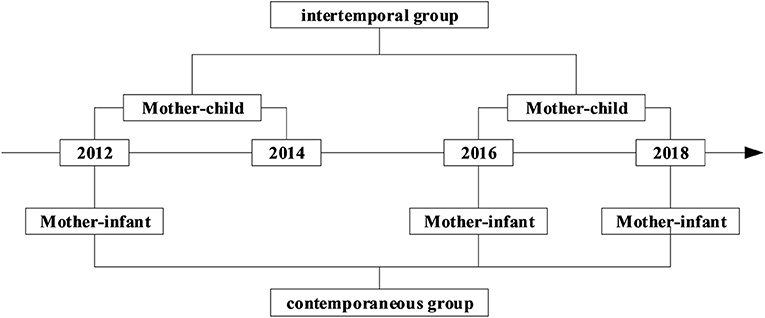
Figure 1. Flow chart of the study groups. The intertemporal group consisted of mothers from 2012 and 2016 who were matched with children from 2014 and 2018, respectively. The contemporaneous group consisted of mother–infant pairs from 2012, 2016, and 2018.
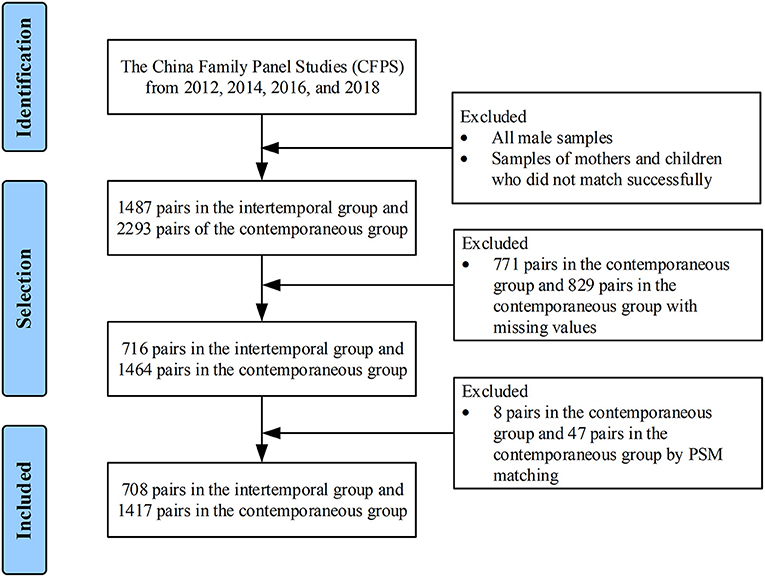
Figure 2. Flow chart of the study participants. Data from the China Family Panel Studies (CFPS) from 2012, 2016, and 2018 were applied.
Measures
Antepartum depression and postpartum depression
The CFPS survey used the Epidemiologic Studies Depression Scale developed by Radloff, which measures the self-rated mental health of respondents using 20 questions (37). Radloff proposed that a score of 16–28 on this scale indicates depressive symptoms, while a score of more than 28 indicates severe depressive symptoms (37). Accordingly, adults who scored more than 28 on the CESD scale of the CFPS2012 and 2016 were defined as “depressed.” In addition, mothers' depression was defined as “antepartum depression” and “postpartum depression” in the intertemporal and contemporaneous groups, respectively.
Neonatal outcomes
In the intertemporal group, neonatal outcomes included the duration of gestation (number of days), birth weight (grams), preterm birth (binary indicator for <37 weeks), birth weight z-score (binary indicator for <-2 or >2, calculated using gestational-age-specific birth weight medians and standard deviations by sex). In the contemporaneous group, neonatal outcomes included weight (grams), weight z-score (binary indicator for <-2 or >2, calculated using gestational-age-specific birth weight medians and standard deviations by sex), illness in the past month (number), and hospitalization in the past year (binary indicator).
Covariates
The following variables were considered as potential confounding factors in previous studies and were controlled for in this study. The mothers' demographics included age, educational attainment, employment status, and health insurance. Families' characteristics included urban households, region, health expenditure, the Engel coefficient, and poor households. Child demographics included sex.
Statistical analysis
We used propensity score matching (PSM), a common method used in observational studies, to reduce selection bias. This allowed us to mimic some of the characteristics of a randomized controlled trial by balancing the distribution of observed covariates in the treated and control groups (38–40). First, we used all the covariates described in the Covariates subsection to calculate the propensity score of depression for each pair. Second, children with depressed mothers were matched at a 1:2 ratio to children with normal mothers using nearest-neighbor matching with replacement, the most common implementation of PSM that minimizes bias in subsequent estimations (41). Lastly, we computed standardized differences in covariates between the treated and control groups before and after matching to assess the improvement of balance in the covariates (Supplemental Technical Note 1) (42). If the standardized difference was < 10%, it was considered an indicator of balance (42).
Following PSM, generalized linear mixed regression analyses (Gaussian family model for continuous outcomes and binomial family model for binary outcomes) were used to examine the effect of mothers' antepartum depression and postpartum depression on neonatal outcomes respectively, accounting for the pairing between the treated and control groups in the intertemporal and contemporaneous groups. All the covariates described in the Covariates subsection were adjusted for in the regression analyses. The final sample sizes for the regression analyses following PSM were 708 and 1,417 in the intertemporal and contemporaneous groups, respectively.
In the sensitivity analysis, we used different PSM methods to determine the robustness of the results. In addition to 1:2 nearest-neighbor matching with replacement in the main analysis, we used 1:2 nearest-neighbor matching with replacement and a caliper of 0.001, and 1:4 nearest-neighbor matching with replacement, kernel matching, radius matching, and a caliper of 0.01. In addition, Meanwhile, we divided the samples into subgroups by sex and urban households of infants or children to test for heterogeneity in each group.
All statistical analyses were performed using Stata 15.1 (Stata Corp., LLC). A p-value < 0.05 was considered statistically significant.
Ethics approval
We only used secondary data from the CFPS database which is open for the public. So we did not collect data from the respondents and thus exempted by the Institutional Review Board (IRB) of our university.
Results
Propensity score matching
Using PSM, we matched 523 mother–child pairs with antepartum depression and 1,044 mother–child pairs with postpartum depression, which constituted the treated group, with mother–child pairs in the intertemporal group and mother–child pairs in the contemporaneous group, which constituted the matched control group. Supplementary Tables 1, 2 show the descriptive statistics.
Figure 3 presents the standardized differences between the treated and control groups before and after 1:2 matching (details are provided in Supplementary Tables 3, 4). In the intertemporal group, some covariates had standardized differences >10% and even up to 20% before matching, but the standardized differences were considerably reduced after matching except for one covariate (age between 23 and 28), which still had a difference >10% and the mean standardized differences reduced from 7.9 to 3.8%, and some covariates had differences reduced to 5% or less. In the contemporaneous group, three covariates had standardized differences >10% before matching, and the standardized differences were reduced to <10% after matching, except for one covariate (junior college), and most standardized differences were reduced to <5%. The mean standardized differences decreased from 5.1 to 4.3%. Therefore, the mean standardized differences were reduced to <5% in both intertemporal and contemporaneous groups. PSM considerably improved comparability between the treated and control groups.

Figure 3. Standardized differences between the treated and control groups before and after propensity score matching. The results of intertemporal group (A) and contemporaneous group (B) are displayed. The black dots represent standardized differences before matching, and the yellow dots represent standardized differences after matching. The 1:2 nearest-neighbor matching with replacement was used. Details are provided in Supplementary Tables 3, 4.
Association estimation after matching
We first performed descriptive statistics on neonatal outcomes and covariates. Tables 1, 2 show the descriptive statistics of the neonatal outcomes in the intertemporal and contemporaneous groups without regression adjustments. Tables 3, 4 show the descriptive statistics of the descriptive statistics of the covariates for the study sample in the intertemporal and contemporaneous groups.

Table 1. Neonatal outcomes between the treated and matched control groups after propensity score matching in the intertemporal group.

Table 2. Neonatal outcomes between the treated and matched control groups after propensity score matching in the contemporaneous group.
We then examined the association between antepartum depression and neonatal outcomes in the intertemporal groups. Figure 4 displays the associations between antepartum depression and neonatal outcomes, which were related to gestational age (details are shown in Supplementary Table 5). Antepartum depression was associated with a shorter duration of gestation by 3.99 days (95% confidence interval [CI] = −7.21, −0.78). But the association between antepartum depression and preterm birth was not significant. Figure 5 presents the associations between antepartum depression and neonatal outcomes, which were related to birth weight (details are shown in Supplementary Table 5). The association between antepartum depression and birth weight and birth weight z-score was not significant.
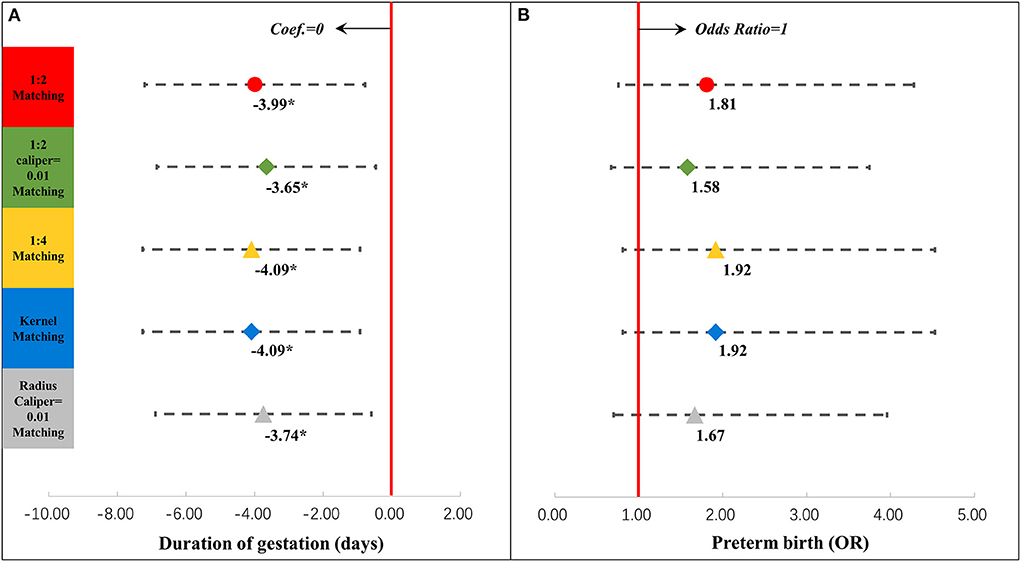
Figure 4. Results of regression analysis of the duration of gestation (A) and preterm birth (B) after propensity score matching. *P < 0.05, **P < 0.01, ***P < 0.001. The results of different propensity score matching analyses are reported too. Dots and lines represent means and 95% confidence intervals for Coef. or ORs estimated from generalized linear mixed regression analyses. Maternal, family, and infant characteristics were also included in the regression analyses but are not reported. Details are provided in Supplementary Table 5. Coef, coefficient; OR, odds ratio.
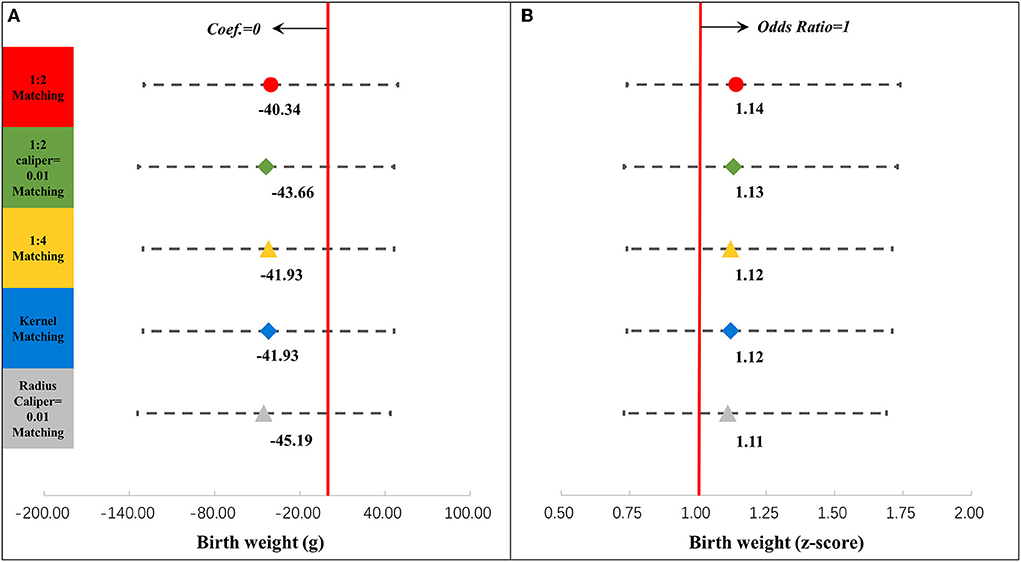
Figure 5. Results of regression analysis of the birth weight (A) and birth weight z-score (B) after propensity score matching. *P < 0.05, **P < 0.01, ***P < 0.001. The results of different propensity score matching analyses are reported too. Dots and lines represent means and 95% confidence intervals for Coef. or ORs estimated from generalized linear mixed regression analyses. Maternal, family, and infant characteristics were also included in the regression analyses but are not reported. Details are shown in Supplementary Table 5. Coef, coefficient; OR, odds ratio.
Meanwhile, we examined the association between postpartum depression and neonatal outcomes in the contemporaneous group. Figure 6 shows the associations between postpartum depression and neonatal outcomes, which were related to weight (details are shown in Supplementary Table 6). The association between postpartum depression and weight or the weight z-score was not significant. Figure 7 displays the associations between postpartum depression and neonatal outcomes, which were related to illness (details are shown Supplementary Table 6). Postpartum depression was associated with more episodes of illness in the last month by 0.23 times (95% CI = 0.11, 0.36) and a higher odd of hospitalization in the last year (OR = 1.59, 95% CI = 1.15, 2.20).
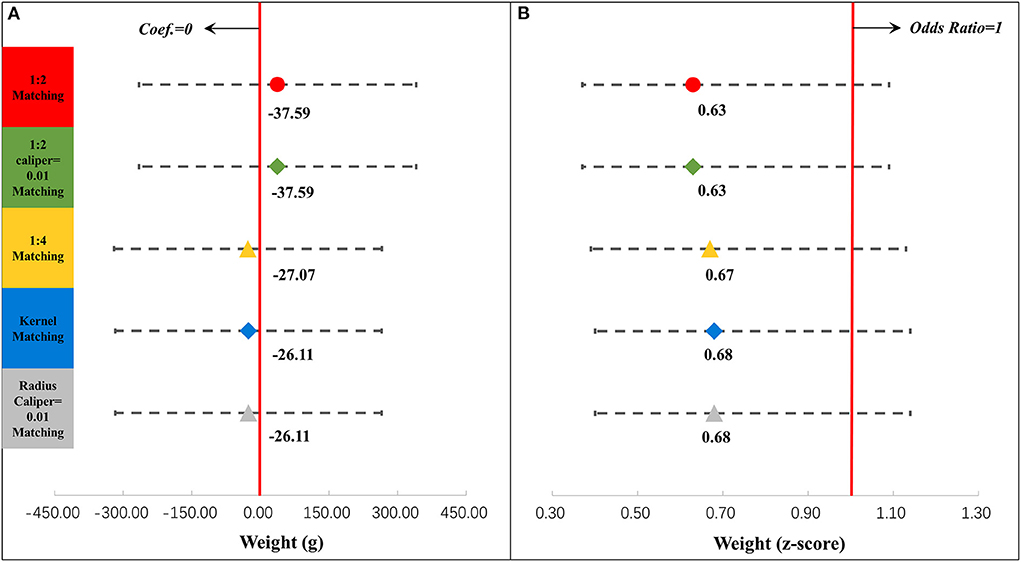
Figure 6. Results of regression analysis of weight (A) and the weight z-score (B) after propensity score matching. *P < 0.05, **P < 0.01, ***P < 0.001. The results of different propensity score matching analyses are reported too. Dots and lines represent means and 95% confidence intervals for Coef. or ORs estimated from generalized linear mixed regression analyses. Maternal, family, and infant characteristics were also included in the regression analyses but are not shown. Details are reported in Supplementary Table 6.
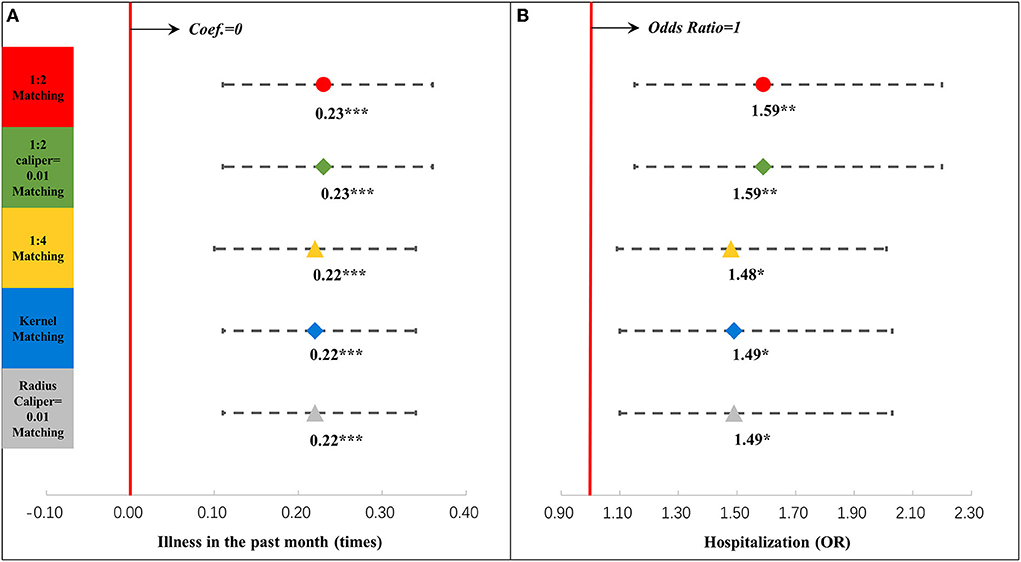
Figure 7. Results of regression analysis of illness in the last month (A) and hospitalization (B) after propensity score matching. *P < 0.05, **P < 0.01, ***P < 0.001. The results of different propensity score matching analyses are shown too. Dots and lines represent means and 95% confidence intervals for Coef. or ORs estimated from generalized linear mixed regression analyses. Maternal, family, and infant characteristics were also included in the regression analyses but are not reported. Details are reported in Supplementary Table 6.
We also demonstrated the after-matching results of subgroups by sex and urban households of infants or children in the appendix (details are shown in Supplementary Tables 7–10).
Discussion
Using a large retrospective cohort in China, this study examined the effects of maternal depression on newborns, which may seriously affect the quality of the birth population. Unlike most previous studies focusing on the effect of antepartum depression or postpartum depression, this study focused on both antepartum depression and postpartum depression. Our PSM analysis revealed that both antepartum and postpartum depression affect newborn health in some ways. Based on the CFPS data, we made several important findings that partially validated our hypotheses.
First, our results showed that antepartum depression was associated with a shorter duration of gestation, but we did not find a significant association between antepartum depression and preterm birth. Larsson et al. found an association between antepartum depressive symptoms and a shorter gestational period of 1 week (13) and other studies have reported no significant association between antepartum depression and preterm birth (14, 16). These studies confirmed our conclusions. But in a previous study from China, Huang et al. reported no link between antepartum depression and preterm birth (43). Furthermore, different from other studies in China (44, 45), the association between antepartum depression and birth weight and birth weight z-scores in our study was not significant. Studies in other countries also suggested no evidence that antepartum depressive symptoms are associated with birth weight (15) or a higher odds of delivering a low-birth-weight infant (16), which was consistent with our conclusion.
It is possible that women with depression may suffer from loss of appetite, difficulty sleeping, lack of energy, weight loss, and other symptoms (8–10), which could biologically affect the fetus. Pregnant women with prenatal depression were also more likely to have pregnancy complications, such as back pain and premature contractions, and were more likely to have mental disorders and fear of childbirth than those without prenatal depression (13). Additionally, mothers with depression are more likely to obtain inadequate medical care or seek medical help than non-depressed mothers (8). But based on our results, all of these potential negative effects of antepartum depression may lead to a shorter duration of gestation, but not so severe as to increase the probability of preterm birth. Meanwhile, our study also proved that antepartum depression was not associated with birth weight.
Second, our study demonstrated that postpartum depression had no significant association with weight or the weight z-score of infants, but postpartum depression was associated with more illnesses in the last month and a higher risk of hospitalization in the previous year. Unlike what we found in our study, evidence from developing countries showed that postpartum depression was associated with early childhood growth, such as being underweight or stunted (30, 35), which was also verified to be true in low-income countries (29). A study on Chinese infants also showed that postpartum depression had a negative effect on the physical development of the baby (46). At the same time, the effect may be persistent, affecting a child's weight gain up to the age of 2 years (32). However, Tomlinson et al. found the same results with us that the association between postpartum and child growth is not significant (34). In addition, many literatures that confirmed that postnatal depressive symptoms can harm a baby's health. A cross-sectional feasibility study in Zambia showed that postpartum depression is associated with more episodes of diarrhea in children. Children with depressed mothers also had more physical problems, such as allergies, asthma, frequent colds, coughs, headaches, and indigestion, than those without non-depressed mothers (47).
Depressive symptoms could also affect maternal care behaviors, such as breastfeeding practices, preparation of appropriate weaning foods, uptake of immunizations, and care-seeking behaviors when children are directly ill (10). Depressed mothers doubt their ability to be a parent (8, 10) and are less likely to provide stimulation and response to their infants than non-depressed mothers (48–50). Consequently, the level of care provided by mothers with depression may put their infants at a higher risk of infection and impaired growth (10). Our findings revealed that maternal depression is a risk factor for the health of newborns and demonstrated the importance of paying attention to women with antepartum depression or postpartum depression in China.
This study has several limitations. First, constrained by the CFPS data, we had to exclude some potential covariates that had too many missing values to keep the sample size as large as possible. We were unable to derive detailed living conditions or childbearing information about mothers, both of which could have potential impacts on neonatal outcomes. Regarding smoking and drinking, as we discussed above, Chinese mothers are less exposed to tobacco and alcohol, but these two factors may have a huge impact on neonatal outcomes (51). Second, we were unable to control for bias from unobserved confounding factors and selection on unobservable confounding factors can still introduce “hidden bias”, although PSM analysis with a range of covariates could balance the measured confounding factors, a limitation common to almost all previous epidemiological studies (52). Third, owing to the nature of the CFPS data, the inability to confirm the exact time of pregnancy and birth could be an issue. However, because of the lack of birth month data, we were able to make a rough intertemporal match between the mother and child to infer when the mother was pregnant, which may have affected our measurements. Lastly, similar to previous findings (25, 31, 32), we found that the effects of postpartum depression on babies can be long-lasting or gradual; some effects do not appear even 5 years later. Because our study only examined 0–1 years old infants after birth, we did not perform a long enough follow-up, so the effects of postpartum depression on a child's growth and development have not been accurately measured. Therefore, it would be worthwhile to investigate and study the long-term effects of maternal prenatal or postnatal depression on children. Future researches are suggested to obtain this.
Despite these limitations, our study has three major strengths. First, we used PSM analysis to improve the validity of comparisons, which have rarely been referred to in previous studies. Second, we used a cohort with CFPS data to verify the influence of maternal depression on newborn health, which compensates for the research gap in China. And the CFPS database allowed us to successfully leverage nationwide, more representative data and reach different conclusions than previous studies. Third, unlike previous studies concentrating only on antepartum depression or postpartum depression, this study verified both.
Conclusions
This study used CFPS data to determine the effect of antepartum and postpartum depression on neonatal outcomes in China. We found that antepartum depression was associated with a shorter duration of gestation. Postpartum depression was also associated with more frequent illnesses and a higher risk of hospitalization. Our study indicated that maternal depression before and after delivery should be addressed in China. Policies aimed at paying attention to antepartum depression and postpartum depression can not only improve the plight of mothers, but it is also an effective way to improve the quality of birth population. With the various neonatal outcomes, more studies are needed to understand their association with maternal depression in the future.
Data availability statement
Publicly available datasets were analyzed in this study. This data can be found here: http://www.isss.pku.edu.cn/cfps.
Author contributions
HL: conceptualization, formal analysis, methodology, formal analysis, and visualization. WN and NZ: formal analysis and visualization. JZ and YM: resources and supervision. RH: supervision. BZ: conceptualization, methodology, visualization, and funding acquisition. All authors contributed to the article and approved the submitted version.
Funding
This study was funded by the Project of Natural Science Foundation of Guangdong Province (2021A1515110617, PI: Zhu).
Conflict of interest
The authors declare that the research was conducted in the absence of any commercial or financial relationships that could be construed as a potential conflict of interest.
Publisher's note
All claims expressed in this article are solely those of the authors and do not necessarily represent those of their affiliated organizations, or those of the publisher, the editors and the reviewers. Any product that may be evaluated in this article, or claim that may be made by its manufacturer, is not guaranteed or endorsed by the publisher.
Supplementary material
The Supplementary Material for this article can be found online at: https://www.frontiersin.org/articles/10.3389/fpubh.2022.893518/full#supplementary-material
References
1. Day LT, Ruysen H, Gordeev VS, Gore-Langton GR, Boggs D, Cousens S, et al. “Every Newborn-BIRTH” protocol: observational study validating indicators for coverage and quality of maternal and newborn health care in Bangladesh, Nepal and Tanzania. J Global Health. (2019) 9:e10902. doi: 10.7189/jogh.09.010902
2. Zeng XY. Current situation and intervention approaches of birth population quality in China. Chin J Population Sci. (2000) 6:1–9.
3. Kong S, Day LT, Bin Zaman S, Peven K, Salim N, Sunny AK, et al. Birthweight: EN-BIRTH multi-country validation study. BMC Pregnancy Childbirth. (2021) 21:355. doi: 10.1186/s12884-020-03355-3
4. Chawanpaiboon S, Vogel JP, Moller A-B, Lumbiganon P, Petzold M, Hogan D, et al. Global, regional, and national estimates of levels of preterm birth in 2014: a systematic review and modelling analysis. Lancet Global Health. (2019) 7:E37–46. doi: 10.1016/S2214-109X(18)30451-0
5. Chang HH, Larson J, Blencowe H, Spong CY, Howson CP, Cairns-Smith S, et al. Preventing preterm births: analysis of trends and potential reductions with interventions in 39 countries with very high human development index editorial comment. Obstet Gynecol Surv. (2013) 68:339–41. doi: 10.1097/01.ogx.0000430376.22369.5c
6. Been JV, Lugtenberg MJ, Smets E, van Schayck CP, Kramer BW, Mommers M, et al. Preterm birth and childhood wheezing disorders: a systematic review and meta-analysis. Plos Med. (2014) 11:1596. doi: 10.1371/journal.pmed.1001596
7. Liu X, Zhou FR, Liu WZ JH Q. Clinical significance of prevention and early intervention of sub-healthy neonates. Chin J Child Health Care. (2009) 17:439–41.
8. Stewart D. Depression during pregnancy. Can Family Physician. (2005) 51:1061–63. doi: 10.1097/OGX.0b013e31824b6f88
9. Schaffir J. Consequences of antepartum depression. Clin Obstet Gynecol. (2018) 61:533–43. doi: 10.1097/GRF.0000000000000374
10. Rahman A, Harrington R, Bunn J. Can maternal depression increase infant risk of illness and growth impairment in developing countries? Child Care Health Dev. (2002) 28:51–6. doi: 10.1046/j.1365-2214.2002.00239.x
11. Chung TKH, Lau TK, Yip ASK, Chiu HFK, Lee DTS. Antepartum depressive symptomatology is associated with adverse obstetric and neonatal outcomes. Psychosom Med. (2001) 63:830–34. doi: 10.1097/00006842-200109000-00017
12. Qq D, Yp L, Hz M, Yz M, QG Z. Depressive symptoms during different period of pregnancy influencing factors. Chin J Reproductive Health. (2017) 28:106–9. doi: 10.3969/j.issn.1671-878X.2017.02.002
13. Larsson C, Sydsjo G, Josefsson A. Health, sociodemographic data, and pregnancy outcome in women with antepartum depressive symptoms. Obstet Gynecol. (2004) 104:459–66. doi: 10.1097/01.AOG.0000136087.46864.e4
14. Nasreen HE, Kabir ZN, Forsell Y, Edhborg M. Low birth weight in offspring of women with depressive and anxiety symptoms during pregnancy: results from a population based study in Bangladesh. BMC Public Health. (2010) 10:515. doi: 10.1186/1471-2458-10-515
15. Gawlik S, Waldeier L, Mueller M, Szabo A, Sohn C, Reck C. Subclinical depressive symptoms during pregnancy and birth outcome-a pilot study in a healthy German sample. Arch Womens Mental Health. (2013) 16:93–100. doi: 10.1007/s00737-012-0320-0
16. Gelaye B, Sanchez SE, Andrade A, Gomez O, Coker AL, Dole N, et al. Association of antepartum depression, generalized anxiety, and posttraumatic stress disorder with infant birth weight and gestational age at delivery. J Affect Disord. (2020) 262:310–16. doi: 10.1016/j.jad.2019.11.006
17. Field T. Maternal depression effects on infants and early interventions. Preventive Medicine. (1998) 27:200–03. doi: 10.1006/pmed.1998.0293
18. Murray L, Cooper PJ. The role of infant and maternal factors in postpartum depression, mother-infant interactions, and infant outcome. In: Murray L, Cooper PJ, editors. Postpartum Depression and Child Development. New York, NY: Guilford Publications (1997). p. 111–35.
19. Murray L, Cooper PJ. Postpartum depression and child development. Psychol Med. (1997) 27:253–60. doi: 10.1017/S0033291796004564
20. Stein A, Pearson RM, Goodman SH, Rapa E, Rahman A, McCallum M, et al. Effects of perinatal mental disorders on the fetus and child. Lancet. (2014) 384:1800–19. doi: 10.1016/S0140-6736(14)61277-0
21. Wachs TD, Black MM, Engle PL. Maternal depression: a global threat to children's health, development, and behavior and to human rights. Child Dev Perspect. (2009) 3:51–9. doi: 10.1111/j.1750-8606.2008.00077.x
22. Galler JR, Harrison RH, Ramsey F, Forde V, Butler SC. Maternal depressive symptoms affect infant cognitive development in Barbados. J Child Psychol Psychiatr. (2000) 41:747–57. doi: 10.1111/1469-7610.00662
23. Lee B, Park HJ. Differences in infant development by trajectories of maternal perinatal depression: based on Malawi mothers and children. Early Child Dev Care. (2020) 190:1441–54. doi: 10.1080/03004430.2018.1538978
24. Yue A, Gao J, Yang M, Swinnen L, Medina A, Rozelle S. Caregiver Depression and Early Child Development: A Mixed-Methods Study From Rural China. Front Psychol. (2018) 9:2500. doi: 10.3389/fpsyg.2018.02500
25. Oyetunji A, Chandra P. Postpartum stress and infant outcome: a review of current literature. Psychiatry Res. (2020) 284:2769. doi: 10.1016/j.psychres.2020.112769
26. Segre LS, O'Hara MW, Arndt S, Stuart S. The prevalence of postpartum depression - The relative significance of three social status indices. Soc Psychiatry Psychiatr Epidemiol. (2007) 42:316–21. doi: 10.1007/s00127-007-0168-1
27. Bauman BL, Ko JY, Cox S, D'Angelo DV, Warner L, Folger S, et al. Vital Signs: postpartum depressive symptoms and provider discussions about perinatal depression - United States, 2018. MMWR Morb Mortal Wkly Rep. (2020) 69:575–81. doi: 10.15585/mmwr.mm6919a2
28. PP Y, JH X. Research about postpartum depression in China from 2014 to 2019. Mat Child Health Care Chin. (2021) 36:4381–84. doi: 10.19829/j.zgfybj.issn.1001-4411.2021.18.075
29. Patel V, Rahman A, Jacob KS, Hughes M. Effect of maternal mental health on infant growth in low income countries: new evidence from South Asia. BMJ. (2004) 328:820–23. doi: 10.1136/bmj.328.7443.820
30. Surkan PJ, Kennedy CE, Hurley KM, Black MM. Maternal depression and early childhood growth in developing countries: systematic review and meta-analysis. Bull World Health Organ. (2011). 89:607–15. doi: 10.2471/BLT.11.088187
31. Surkan PJ, Ettinger AK, Hock RS, Ahmed S, Strobino DM, Minkovitz CS. Early maternal depressive symptoms and child growth trajectories: a longitudinal analysis of a nationally representative US birth cohort. BMC Pediatr. (2014) 14:185. doi: 10.1186/1471-2431-14-185
32. Wojcicki JM, Holbrook K, Lustig RH, Epel E, Caughey AB, Munoz RF, et al. Chronic maternal depression is associated with reduced weight gain in latino infants from birth to 2 years of age. Plos ONE. (2011) 6:16737. doi: 10.1371/journal.pone.0016737
33. Gaffney KF, Kitsantas P, Brito A, Swamidoss CSS. Postpartum depression, infant feeding practices, and infant weight gain at six months of age. J Pediatr Health Care. (2014) 28:43–50. doi: 10.1016/j.pedhc.2012.10.005
34. Tomlinson M, Cooper PJ, Stein A, Swartz L, Molteno C. Post-partum depression and infant growth in a South African peri-urban settlement. Child Care Health Dev. (2006) 32:81–6. doi: 10.1111/j.1365-2214.2006.00598.x
35. Ndokera R, MacArthur C. The relationship between maternal depression and adverse infant health outcomes in Zambia: a cross-sectional feasibility study. Child Care Health Dev. (2011) 37:74–81. doi: 10.1111/j.1365-2214.2010.01129.x
36. Ye X, Zhu D, He P. The Long-Term impact of adversity in adolescence on health in middle and older adulthood: a natural experiment from the chinese send-down movement. Am J Epidemiol. (2021) 190:1306–15. doi: 10.1093/aje/kwab035
37. Radloff LS. The Use of the center for epidemiologic studies depression scale in adolescents and young-adults. J Youth Adolesc. (1991) 20:149–66. doi: 10.1007/BF01537606
38. Austin PC, Grootendorst P, Anderson GM. A comparison of the ability of different propensity score models to balance measured variables between treated and untreated subjects: a Monte Carlo study. Stat Med. (2007) 26:734–53. doi: 10.1002/sim.2580
39. Thoemmes FJ, Kim ES. A systematic review of propensity score methods in the social sciences. Multivariate Behav Res. (2011) 46:90–118. doi: 10.1080/00273171.2011.540475
40. Austin PC. An introduction to propensity score methods for reducing the effects of confounding in observational studies. Multivariate Behav Res. (2011) 46:399–424. doi: 10.1080/00273171.2011.568786
41. Austin PC. Statistical criteria for selecting the optimal number of untreated subjects matched to each treated subject when using many-to-one matching on the propensity score. Am J Epidemiol. (2010) 172:1092–97. doi: 10.1093/aje/kwq224
42. Austin PC. Using the standardized difference to compare the prevalence of a binary variable between two groups in observational research. Communications Statistics-Simulation Computation. (2009) 38:1228–34. doi: 10.1080/03610910902859574
43. Mx H, W J, Ly P, Wl L, St S, X X, et al. Effects of prenatal depression on birth weight and gestational age Maternal and Child. Health Care Chin. (2020) 35:1585–91.
44. Y Z, Mx Z, Hj W, Dh M, Jj L, P Z. Association between depression in late pregnancy and fetal weight development. Acta Universitatis Medicinalis Anhui. (2017) 52:388–91. doi: 10.19405/j.cnki.issn1000-1492.2017.03.018
45. JJ L W Z, YS W. Effects of prenatal depression on neonatal health maternal and child. Health Care Chin. (2012) 27:4539–41.
46. Xj W, Jj Z, Xh L. Effects of postpartum depression on infant development. Chin J Clin. (2017) 45:105–9. doi: 10.3969/j.issn.1008-1070.2017.10.040
47. Billings AG, Moos RH. Comparisons of children of depressed and nondepressed parents. - a social-environmental perspective. J Abnorm Child Psychol. (1983) 11:463–86. doi: 10.1007/BF00917076
48. Bettes BA Maternal depression and motherese. - temporal and intonational features. Child Dev. (1988) 59:1089–96. doi: 10.2307/1130275
49. Livingood AB, Daen P, Smith BD. The depressed mother as a source of stimulation for her infant. J Clinical Psychol. (1983) 39:369–75. doi: 10.1002/1097-4679(198305)39:3<369::AID-JCLP2270390310=3.0.CO;2-8
50. Field T, Healy B, Goldstein S, Guthertz M. Behavior-state matching and synchrony in mother infant interactions of nondepressed versus depressed. dyads. Dev Psychol. (1990) 26:7–14. doi: 10.1037/0012-1649.26.1.7
51. Parcells DA. Women's mental health nursing: depression, anxiety and stress during pregnancy. J Psychiatr Ment Health Nurs. (2010) 17:813–20. doi: 10.1111/j.1365-2850.2010.01588.x
Keywords: birth quality, cohort study, maternal depression, neonatal outcomes, propensity score matching
Citation: Li H, Ning W, Zhang N, Zhang J, He R, Mao Y and Zhu B (2022) Association between maternal depression and neonatal outcomes: Evidence from a survey of nationally representative longitudinal studies. Front. Public Health 10:893518. doi: 10.3389/fpubh.2022.893518
Received: 10 March 2022; Accepted: 22 August 2022;
Published: 09 September 2022.
Edited by:
Naseem Akhtar Qureshi, Al-Falah University, IndiaReviewed by:
Hao Xue, Stanford University, United StatesHaofei Hu, Shenzhen Second People's Hospital, China
Copyright © 2022 Li, Ning, Zhang, Zhang, He, Mao and Zhu. This is an open-access article distributed under the terms of the Creative Commons Attribution License (CC BY). The use, distribution or reproduction in other forums is permitted, provided the original author(s) and the copyright owner(s) are credited and that the original publication in this journal is cited, in accordance with accepted academic practice. No use, distribution or reproduction is permitted which does not comply with these terms.
*Correspondence: Ying Mao, bWFvX3lpbmdAbWFpbC54anR1LmVkdS5jbg==; Bin Zhu, emh1YjZAc3VzdGVjaC5lZHUuY24=
 Haoran Li1
Haoran Li1 Rongxin He
Rongxin He Ying Mao
Ying Mao Bin Zhu
Bin Zhu